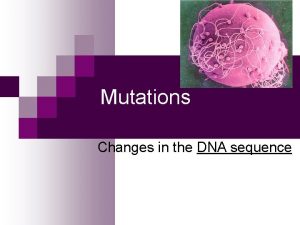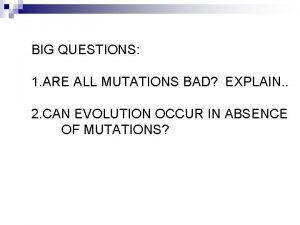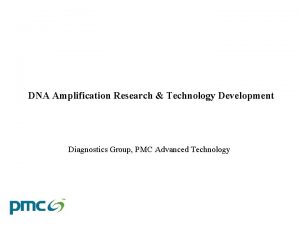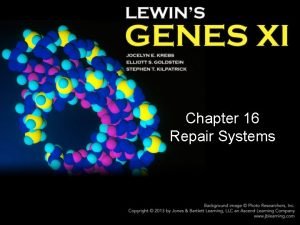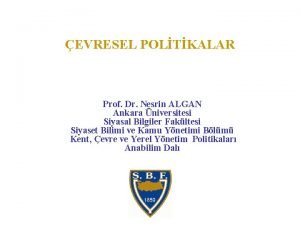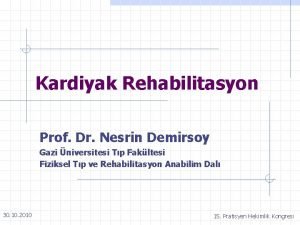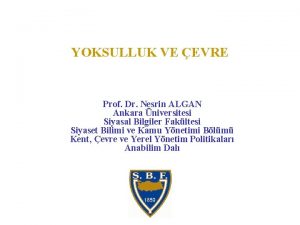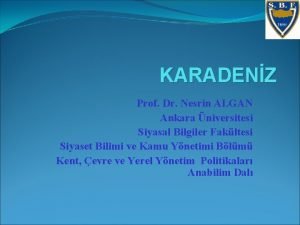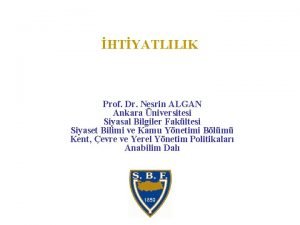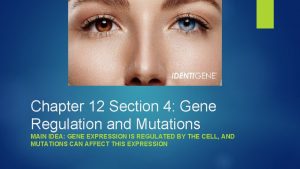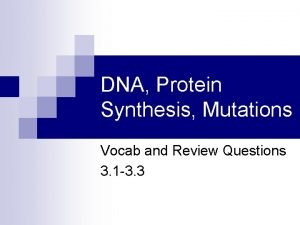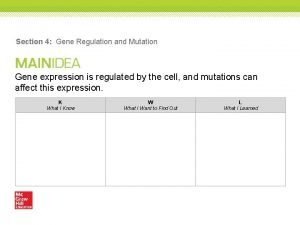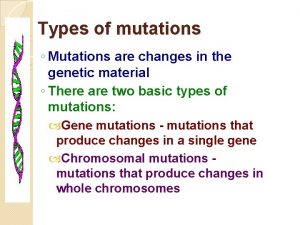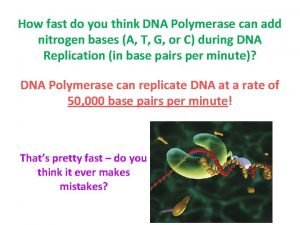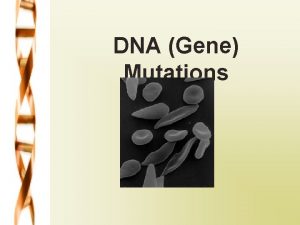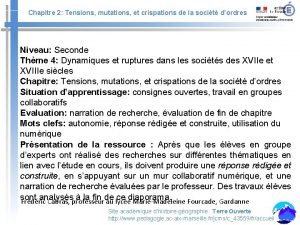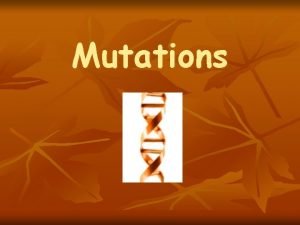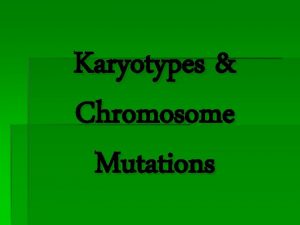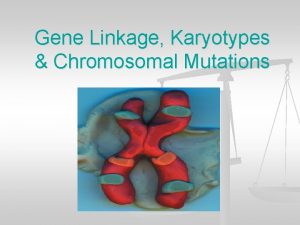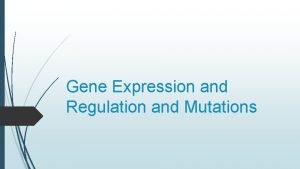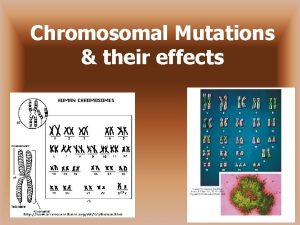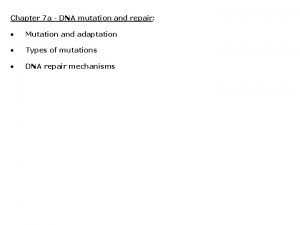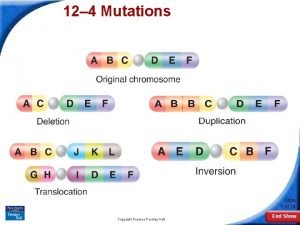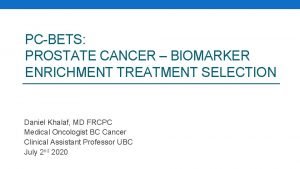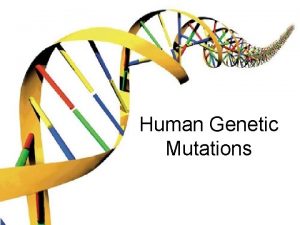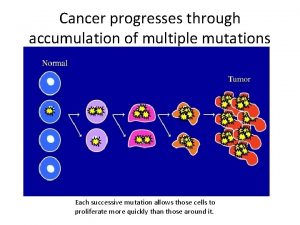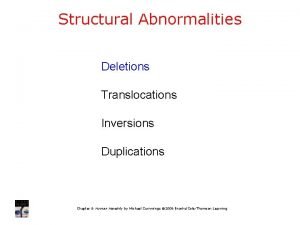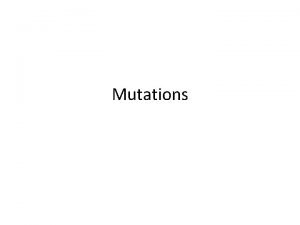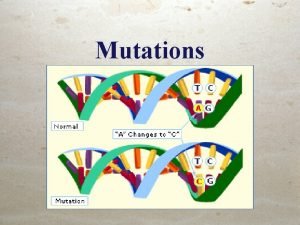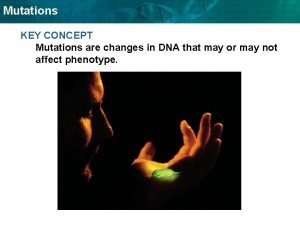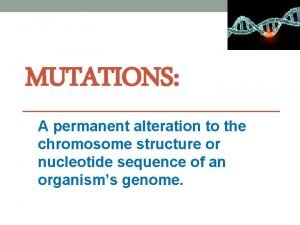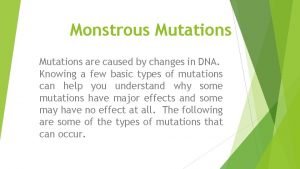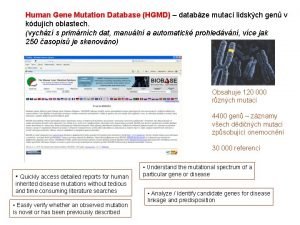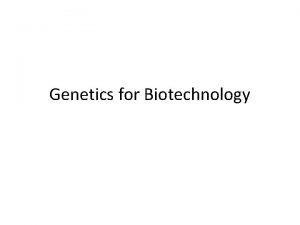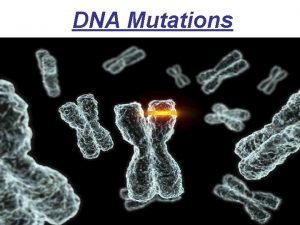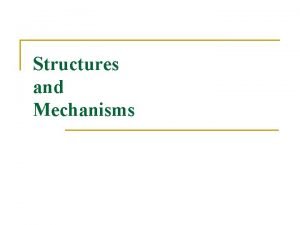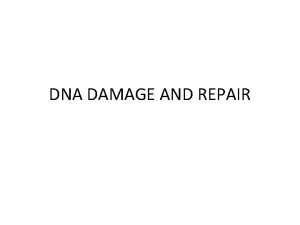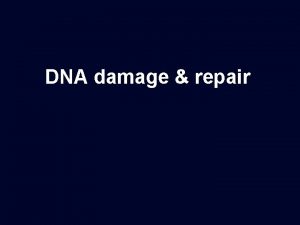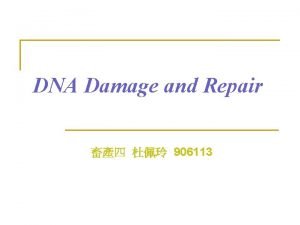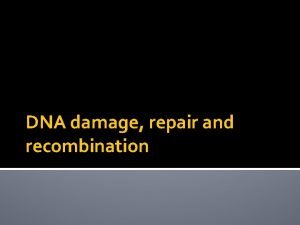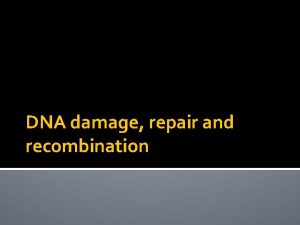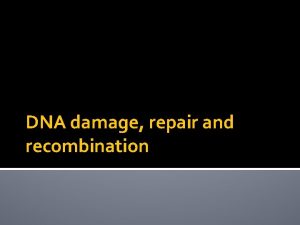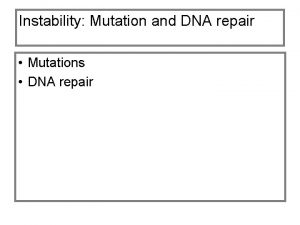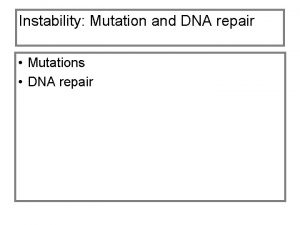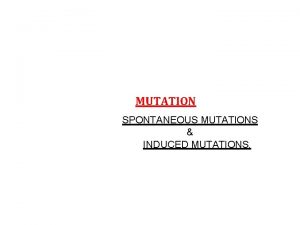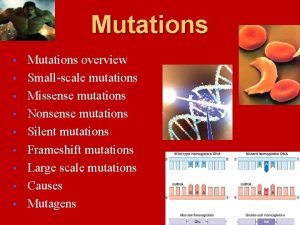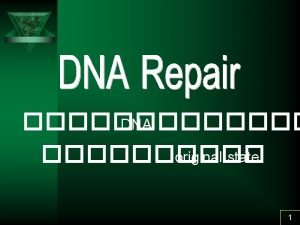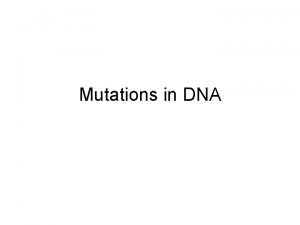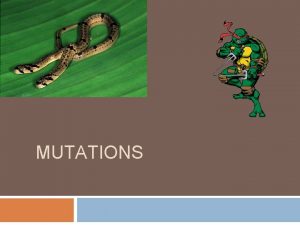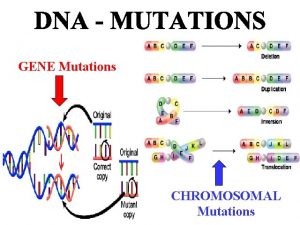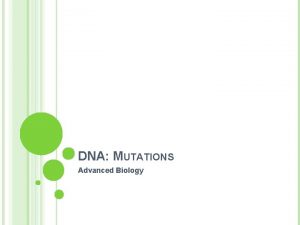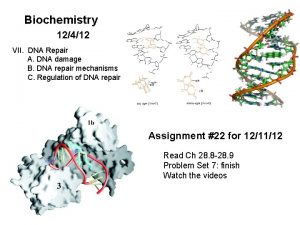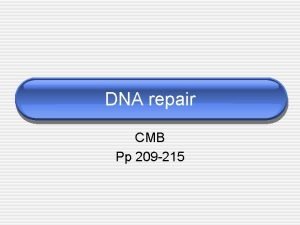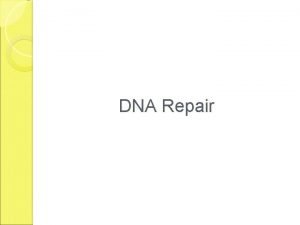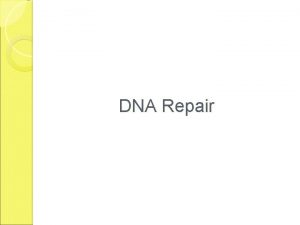DNA Damage Mutations and Repair Mechanisms Dr Nesrin



















































- Slides: 51

ﺧﻠﻴﻚ ﺑﺎﻟﺒﻴﺖ DNA Damage, Mutations and Repair Mechanisms Dr. Nesrin Mwafi Biochemistry & Molecular Biology Department Faculty of Medicine, Mutah University

DNA Damage ﺧﻠﻴﻚ ﺑﺎﻟﺒﻴﺖ • DNA molecules like all other biomolecules can be damaged in numerous ways • DNA damage occurs at a rate of 104 – 106 molecular lesions per cell per day • What are the sources and types of this damage? • Can our cells recognise and repair this damage? • What are the consequences of unrepaired damage on the cell fate?


Classification of DNA Damage ﺧﻠﻴﻚ ﺑﺎﻟﺒﻴﺖ • DNA damage can be classified according to the causative agents into two main types: A. Spontaneous damage (Endogenous): arising naturally and in the absence of known causative agents. Spontaneous DNA lesions are random events B. Induced damage (Exogenous): occurs in the presence of known causative agents (external factors)

Spontaneous DNA Damage ﺧﻠﻴﻚ ﺑﺎﻟﺒﻴﺖ • Although DNA is highly stable, nevertheless it is susceptible to the following spontaneous changes under normal cell conditions: 1. 2. 3. 4. 5. Deamination Depurination Replication errors Base tautomers Oxidative DNA damage

Spontaneous DNA Damage ﺧﻠﻴﻚ ﺑﺎﻟﺒﻴﺖ 1. Deamination: the most common type is the spontaneous deamination of cytosine to uracil which occurs at a rate of about 100 bases/cell/day

Nitrogenous Bases ﺧﻠﻴﻚ ﺑﺎﻟﺒﻴﺖ (in RNA )

Nitrogenous Bases 9 6 4 1 ﺧﻠﻴﻚ ﺑﺎﻟﺒﻴﺖ 5 3 2 Purines Pyrimidines 9 4 6 1 2 3 2

Deamination • Other possible deamination events in DNA: ﺧﻠﻴﻚ ﺑﺎﻟﺒﻴﺖ

Deamination ﺧﻠﻴﻚ ﺑﺎﻟﺒﻴﺖ T Nitrogenous base Original base pair Deamination product which base pairs with ( ) 1 st round Substituted base pair 2 nd round Cytosine C-G Uracil (A) T-A Adenine A-T Hypoxanthine (C) G-C Guanine G-C Xanthine (T) A-T 5 -Me cytosine C-G Thymine (A) T-A Thymine T-A

Deamination ﺧﻠﻴﻚ ﺑﺎﻟﺒﻴﺖ • The chemistry of DNA four bases facilitates the damage detection through mismatched base pairs • Specific DNA repair enzymes (i. e. DNA N - glycosylases) are capable of detection and removal of such unusual bases • If left uncorrected, during DNA replication most of these changes would lead to mutations in the daughter DNA chain (particularly base pair substitution) • These mutations will propagate throughout subsequent cell generations (inherited)

Spontaneous DNA Damage ﺧﻠﻴﻚ ﺑﺎﻟﺒﻴﺖ 2. Depurination: the loss of a purine base by spontaneous hydrolysis of the N-glycosidic bond that links it to deoxyribose C 1’ apurinic site (AP site) AP site

Depurination ﺧﻠﻴﻚ ﺑﺎﻟﺒﻴﺖ • Under physiological conditions, depurination occurs at a rate of about 5000 bases/cell/day • Depurination results in apurinic site (AP site) which can be recognized and repaired by specific repair mechanisms • If left uncorrected, during DNA replication these changes would lead to mutations in the daughter DNA chain (particularly base pair deletion) • This error will propagate throughout subsequent generations (inherited)

Depurination (AP site) ﺧﻠﻴﻚ ﺑﺎﻟﺒﻴﺖ

Spontaneous DNA Damage ﺧﻠﻴﻚ ﺑﺎﻟﺒﻴﺖ 3. Replication errors: spontaneous lesions may occur during DNA replication in which the wrong base is add to the newly synthesized strand (base substitution), a DNA base is skipped (base deletion) or extra base is added (base insertion) • Such errors are normally detected and repaired immediately by the proofreading/editing activity of DNA polymerase enzyme (3’-5’ exonuclease activity) • Otherwise, DNA repair enzymes will recognize the mismatched base pairs and repair them

Spontaneous DNA Damage ﺧﻠﻴﻚ ﺑﺎﻟﺒﻴﺖ 4. Base tautomers: DNA bases exist in one of several forms called tautomers (structural isomers) 1. Keto/Enol pair tautomerization 2. Amine/Imine pair tautomerization

Base Tautomers • Actually enol/imine forms are rare and tend to cause mispairing ﺧﻠﻴﻚ ﺑﺎﻟﺒﻴﺖ

Base Tautomers • If not repaired, it can lead to tautomeric shift mutation ﺧﻠﻴﻚ ﺑﺎﻟﺒﻴﺖ

Spontaneous DNA Damage ﺧﻠﻴﻚ ﺑﺎﻟﺒﻴﺖ 5. Oxidative DNA Damage: Endogenous Reactive Oxygen Species (ROS) are produced as byproducts during normal metabolic processes • ROS such as superoxide radical. O 2 - attack DNA leading to damage. They can chemically modify nitrogenous bases leading to mispairing • 8 -oxoguanine (8 -oxo G) is one of the major product of DNA oxidation. Another modified base is thymine glycol

Oxidative DNA Damage Guanine (G) ﺧﻠﻴﻚ ﺑﺎﻟﺒﻴﺖ 8 -oxoguanine (8 -oxo G)

Induced DNA damage ﺧﻠﻴﻚ ﺑﺎﻟﺒﻴﺖ 1. Radiation damage: which includes both UV light and ionizing radiation

Induced DNA damage ﺧﻠﻴﻚ ﺑﺎﻟﺒﻴﺖ A. Ultraviolet Radiation • • • Pyrimidines are highly sensitive to UV light. They form pyrimidine dimer (intra-strand crosslinking) particularly thymine dimer (T-dimer) Dimers alter DNA structure (kink or knot in DNA strand) Thymine dimers prevent proper replication. The cell either dies (apoptosis) or forms a malignant tumour (cancer)


Induced DNA damage ﺧﻠﻴﻚ ﺑﺎﻟﺒﻴﺖ B. Ionizing Radiation: like cosmic rays, X-rays and gamma rays can damage DNA molecules in 2 ways: • Direct DNA damage by producing single strand break (SSB) and the more severe double strand break (DSB) • Indirect DNA damage by production of free radicals which alter the structure of bases

Induced DNA damage ﺧﻠﻴﻚ ﺑﺎﻟﺒﻴﺖ 2. Chemical mutagens: are agents which induce mutations if their damaging effects on DNA have not been recognized and repaired – Base modifying agents – Base analogs – Intercalating agents

Base Modifying Agents ﺧﻠﻴﻚ ﺑﺎﻟﺒﻴﺖ • Change or modifiy the chemical structure of DNA bases resulting in mispairing and other problems • These includes alkylating agents such as SAM (s -adenosyl Methionine) which adds methyl group to guanine leading to O 6 methylguanine (O 6 Me. G) • If not repaired, this lesion can lead to a base pair substitution (base pair changers)

Base analogs ﺧﻠﻴﻚ ﺑﺎﻟﺒﻴﺖ • Chemicals with structures similar to that of any of the four standard bases of DNA like 2 -amino purine the base analog of adenine (6 -amino purine). They replace them in DNA strand but do not always pair with normal bases leading to base pair substitution (e. g. AT bp is replaced with GC bp)

Intercalating Agents • Sandwich themselves between adjacent DNA bases like acridine orange, benzopyrene (cigarette smoke), aflatoxin B 1 (mycotoxins produced by some fungi) • They affect DNA structure causing insertion or deletion of an entire base pair leading to frameshift mutation ﺧﻠﻴﻚ ﺑﺎﻟﺒﻴﺖ

ﺧﻠﻴﻚ ﺑﺎﻟﺒﻴﺖ DNA Repair Pathways

DNA Repair Mechanisms ﺧﻠﻴﻚ ﺑﺎﻟﺒﻴﺖ • DNA repair system : is a collection of processes by which a cell identifies and corrects various DNA lesions • Several repair strategies are available: A. B. C. D. E. Direct/reversal repair Base excision repair (BER) Nucleotide excision repair (NER) Strand-directed Mismatch repair (MMR) Double strand breaks repair (DSB)

Direct Repair system ﺧﻠﻴﻚ ﺑﺎﻟﺒﻴﺖ • Direct repair also called direct reversal because the damage can be directly recognized and reversed • Two specific enzymes are involved in direct repair: 1. Photolyases which repair UV induced damage in plants, bacteria and some animals (excluding humans) by splitting the dimers

Direct Repair system 2. O 6 -methylguanine methyltransferase (MGMT) which transfer methyl group from G to a cysteine residue within the enzyme itself. Ada and Ogt are the two bacterial isoforms of MGMT • This reaction is stoichiometric rather than catalytic because each enzyme can be used only once (suicide) ﺧﻠﻴﻚ ﺑﺎﻟﺒﻴﺖ

Base Excision Repair ﺧﻠﻴﻚ ﺑﺎﻟﺒﻴﺖ • Base excision repair (BER) involves a category of enzymes known as DNA-N-glycosylases like uracil DNA glycosylase • Glycosylases recognize damaged bases and remove them resulting in apurinic or apyrimidinic (AP) site • AP endonucleases enzymes nick the damaged backbone at 5’ end of AP site • DNA polymerase removes the damaged region using its 5’ to 3’ exonuclease activity and correctly synthesizes the new strand. Finally, DNA ligase seals the strand.

Base Excision Repair Uracil- ﺧﻠﻴﻚ ﺑﺎﻟﺒﻴﺖ

Nucleotide Excision Repair ﺧﻠﻴﻚ ﺑﺎﻟﺒﻴﺖ • Nucleotide excision repair system (NER) corrects lesions which commonly cause bulk distortions in DNA helix like UV-induced pyrimidine dimers. NER is highly conserved used in both eukaryotes and prokaryotes • The damaged region is removed in 3 steps process: 1. Recognition of the damage by NER enzymes 2. Excision of damaged DNA (12 -24 nucleotides long) by endonucleases 3. Resynthesis of removed DNA region by DNA polymerase followed by ligase to seal the region

Nucleotide Excision Repair ﺧﻠﻴﻚ ﺑﺎﻟﺒﻴﺖ

Nucleotide Excision Repair • ﺧﻠﻴﻚ ﺑﺎﻟﺒﻴﺖ Xeroderma pigmentosum (XP) is a recessive disorder in which victims lack the normal UV repair enzymes (NER genes). This creates hypersensitivity to sunlight and a tendency to develop skin cancer

Strand-directed Mismatch Repair ﺧﻠﻴﻚ ﺑﺎﻟﺒﻴﺖ • Mismatch repair (MMR) corrects errors introduced during DNA replication (e. g. base substitution, deletions or insertions) • Replication errors are rare due to high fidelity of DNA replication process • DNA polymerases have proofreading 3’-5’ exonuclease (reverse) activity which recognizes mismatched bases and excises them

Strand-directed Mismatch Repair ﺧﻠﻴﻚ ﺑﺎﻟﺒﻴﺖ • Mismatch system recognizes and corrects errors that escaped from DNA polymerase proofreading machinery • 3 steps process: 1. Mismatched base pair is recognized 2. Excision of DNA segment containing the mismatched nucleotide from the newly synthesized strand 3. Resynthesis of the excised segment • It is called strand-directed MMR because MMR enzymes are selectively directed to the newly synthesized strand rather than to the old strand

Double strand breaks repair (DSB) ﺧﻠﻴﻚ ﺑﺎﻟﺒﻴﺖ • A dangerous type of DNA damage which can lead to chromosomes fragmentation and consequently loss of genes (chromosomal aberration) if left unrepaired • Two types of repair mechanisms: 1. Non-homologous End Joining (NHEJ): it is an errorprone mechanism of repair because it results in a change of DNA sequence at the site of breakage 2. Homologous recombination (HR) is an error-free mechanism of repair because the damage is accurately repaired using information from sister chromatid

Double strand breaks repair (DSB) ﺧﻠﻴﻚ ﺑﺎﻟﺒﻴﺖ


DNA Damage and Mutation ﺧﻠﻴﻚ ﺑﺎﻟﺒﻴﺖ DNA damage Defective Repair systems Repair enzymes Normal cells Mutation Diseased cells • Mutation is an alteration in genetic sequence having tricked the DNA repair systems and thus getting replicated in the future (inherited, permanent and unrepaired lesion)

Structural Classification of Mutation Point mutation Substitution Transition Frameshift mutation Insertion Transversion Deletion ﺧﻠﻴﻚ ﺑﺎﻟﺒﻴﺖ

Frameshift Mutation ﺧﻠﻴﻚ ﺑﺎﻟﺒﻴﺖ • Frameshift mutation: any addition (insertion) or deletion which alters the reading frame (i. e. not in a multiple of three)

Point Mutation ﺧﻠﻴﻚ ﺑﺎﻟﺒﻴﺖ • Point mutation: an alteration in DNA sequence by a single nucleotide base and consequently a change in single base pair (substitution) • Substitution at a point is called Transition if one purine is replaced with another purine or one pyrimidine with another pyrimidine and it is called Transversion if one purine is replaced with one pyrimidine or vise versa

Point Mutation ﺧﻠﻴﻚ ﺑﺎﻟﺒﻴﺖ Point mutation Nonsense Missense Conservative Silent Nonconservative • At the protein level, point mutation is classified: 1. 2. 3. Silent mutation Nonsense mutation Missense mutation (conservative and non-conservative)

Point Mutation ﺧﻠﻴﻚ ﺑﺎﻟﺒﻴﺖ 1. Silent mutation: a change in triplet codon without a change in the encoded amino acid. Thus, it has no effect on the protein sequence 2. Nonsense mutation: the codon changes from amino acid codon to stop codon resulting in truncated protein (mostly non-functional) 3. Missense mutation: codon change alters the amino acid encoded. It could be conservative if the new amino acid is chemically similar to the original one or non-conservative if it is chemically dissimilar



ﺧﻠﻴﻚ ﺑﺎﻟﺒﻴﺖ Summary & Take home message
 Dna types of mutations
Dna types of mutations Are all mutations bad? *
Are all mutations bad? * Mutations in dna
Mutations in dna Dna repair pathways
Dna repair pathways Rec a
Rec a Nesrin algan
Nesrin algan Nesrin demirsoy
Nesrin demirsoy Nesrin algan
Nesrin algan Nesrin algan
Nesrin algan Nesrin algan
Nesrin algan Dna primase
Dna primase Coding dna and non coding dna
Coding dna and non coding dna Dna polymerase function in dna replication
Dna polymerase function in dna replication Bioflix activity dna replication lagging strand synthesis
Bioflix activity dna replication lagging strand synthesis Replication process
Replication process Dna and genes chapter 11
Dna and genes chapter 11 Section 4 gene regulation and mutation
Section 4 gene regulation and mutation Missense mutation in sickle cell anemia
Missense mutation in sickle cell anemia Protein synthesis and mutations
Protein synthesis and mutations Protein synthesis and mutations
Protein synthesis and mutations Section 4 gene regulation and mutation
Section 4 gene regulation and mutation Types of mutations
Types of mutations What are some neutral mutations
What are some neutral mutations Cytoplasm structure
Cytoplasm structure What causes mutation
What causes mutation Chapter 14 lesson 4 mutations
Chapter 14 lesson 4 mutations Tensions mutations et crispations de la société d'ordres
Tensions mutations et crispations de la société d'ordres Beneficial mutations examples
Beneficial mutations examples Mutated karyotype
Mutated karyotype Karyotype mutations
Karyotype mutations Types of mutations
Types of mutations Chromosomal mutation
Chromosomal mutation Mutation and adaptation
Mutation and adaptation 12-4 mutations
12-4 mutations Cancer mutations
Cancer mutations Two types of point mutation
Two types of point mutation Cancer mutations
Cancer mutations Cancer mutations
Cancer mutations Mutation reverse
Mutation reverse Kinds of chromosomal mutations
Kinds of chromosomal mutations Chromosomal mutations
Chromosomal mutations Chromosomal mutation vs gene mutation
Chromosomal mutation vs gene mutation Gene mutations
Gene mutations Vertus hardiman
Vertus hardiman Monstrous mutations
Monstrous mutations Types of mutations
Types of mutations Databze
Databze Gamete mutation definition
Gamete mutation definition Central dogma
Central dogma Types of mutation
Types of mutation Structure of virtualization in cloud computing
Structure of virtualization in cloud computing Structure and mechanism
Structure and mechanism
